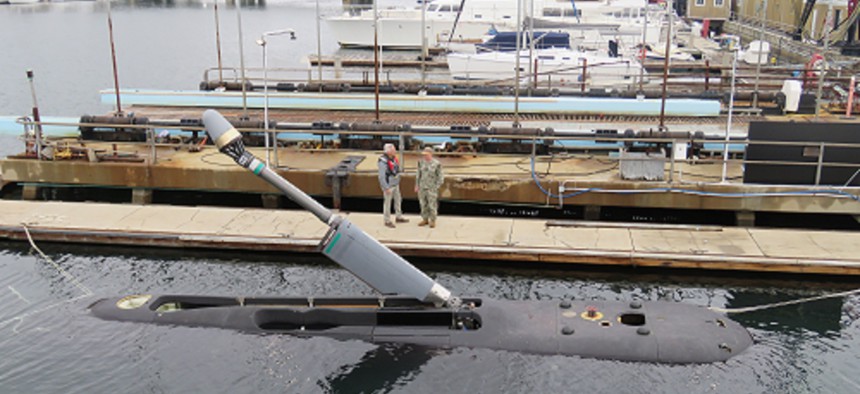
Boeing
The Navy has its first giant robotic submarine
The Boeing-made vessel will now undergoing trials that will inform future robo subs.
Boeing has delivered a large robotic submarine to the U.S. Navy following a series of sea trials, the company and service announced Wednesday.
Called Orca, the diesel-electric Extra-Large Unmanned Undersea Vehicle, or XLUUV, will be used for tests that help the Navy round out concepts for uncrewed submarines and surface vessels.
While the Navy hasn’t disclosed the exact specifications of the submarine, it’s based on Boeing’s Echo Voyager, a 51-foot-long, 8.5-foot-wide, non-militarized prototype. It can be equipped with payload modules of up to 34 feet, bringing its full length to about 85 feet—about one-quarter as long as the Navy’s Virginia-class attack submarines.
Orca “can perform long duration critical missions to achieve undersea maritime dominance in changing environments and contested waters,” Boeing said in a statement. The company bills the robo sub as “the most advanced and capable UUV in the world.”
Like an unmanned, underwater littoral combat ship, the sub is designed to carry various payload modules that can be swapped out for different missions.
“Configured to accommodate various payloads, the Orca XLUUV allows for the seamless integration of sensors, communication systems, and other mission-specific components, adapting to the evolving requirements of naval operations,” the Navy said in a statement.
The Navy has designated the first Orca as Test Asset System, or XLE0.
“Lessons learned from XLE0’s testing will be applied to Orca XLUUV 1 through 5, which will be built and delivered to the Navy in the future,” the Navy said in a statement.
The crewless submarine is designed to remain at sea for “months at a time in open, congested and contested waters with little-to-no human intervention,” according to Boeing.
The company in July posted a video of Orca at sea surrounded by dozens of dolphins.
“Orca has undergone several phases of at-sea testing, including above and below surface maneuvers to demonstrate the vehicles’ unique capabilities,” Boeing said.
For years, Pentagon officials have talked about how large robotic submarines could help the U.S. military increase its capabilities, especially in the Pacific region and against China’s military build-up. The Orca XLUUV appears to be the largest of the Navy’s robosub efforts. Earlier this year, the service canceled an effort to field robotic submarines that were smaller than Orca.
In late 2016, then-Deputy Defense Secretary Robert Work visited the Huntington Beach, California, factory where Boeing builds Orca. At the time, he saw the Echo Voyager, which now has spent over 10,000 hours at sea and “transited hundreds of nautical miles autonomously,” the company said.
In 2017, Boeing teamed with shipbuilding stalwart HII to build Orca. In early 2021, HII announced it had completed construction of a factory that would assemble Orca hull structures.




